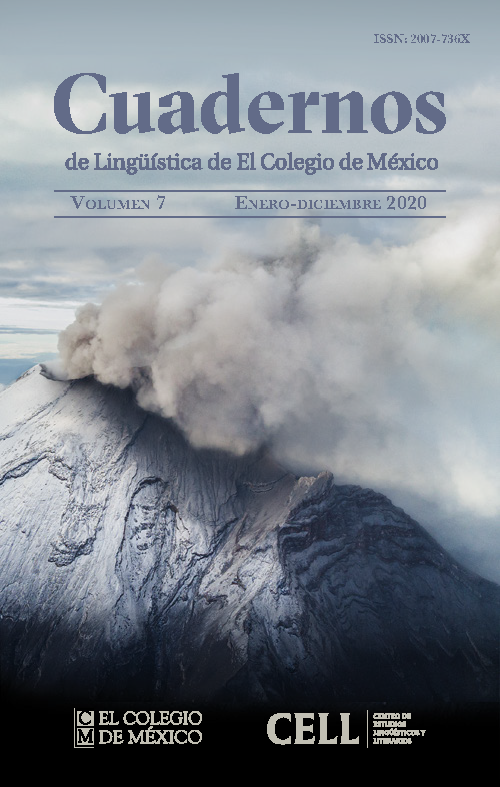Lexical and syntactic contexts of hesitation phenomena in formal deputy-citizen interviews conducted at Mexico City congress
DOI:
https://doi.org/10.24201/clecm.v7i0.141Keywords:
hesitation markers, discursvie planning, oral language, word classes, repertoire, translanguaging theoryAbstract
This article, which is an outcome of an ethnographic research, aims to offer an insight into lexical and syntactic contexts of some hesitation phenomena (short fillers, repetitions, long fillers, word lengthening, unfinished words and unfinished phrases), identified in a corpus sample that consists of structured interviews conducted by a group of deputies of Mexico City Local Congress with citizens who applied for the ombudsperson’s position at the city’s Human Rights Office (Comisión de Derechos Humanos de la Ciudad de México). Drawing upon a lexical and syntactic description, some remarks on the hesitation phenomena’s linguistic and communicative values are presented. I propose an interpretation of hesitation occurrence patterns that appear in the respondent’s answers. This interpretation is based on the discursive planning level, the interaction between hesitation markers and word classes, and the concept of repertoire as it has been used in the theory of translanguaging. Towards the end of the manuscript I argue that the studied phenomena and their distribution are directly related to open class words, and the cognitive effort of producing grammatical, accurate and socially appropriate messages.
Downloads
References
Allwood, J.; Nivre, J.; y Ahlsén, E. 1990. Speech Management on the Non-Written Life of Speech. Nordic Journal of Linguistics 13(1). 1–45.
Ávila, Silvia. 1999. El análisis del diálogo desde la perspectiva de los estudios de la interacción verbal: los marcadores de vacilación en la entrevista radiofónica. México, D.F.: UNAM. (Tesis de licenciatura).
Bloch, Bernard. 1950. Studies in colloquial Japanese IV. Phonemics. Language 26. 86–125. DOI: 10.2307/410409.
Bortfeld, Heather; Leon, Siliva D.; Bloom, Jonathan E.; Shchober, Michael F. & Brennan, Susan E. 2001. Disfluency rates in conversation: Effects of age, relationship, topic, role, and gender. Language and Speech 44(2).123–147. DOI: 10.1177/00238309010440020101.
Briz Gómez, Antonio. 2001 [1998]. El español coloquial en la conversación: esbozo de pragmagramática. Barcelona: Ariel Lingüística.
Cameron, Deborah. 2012 [1995]. Verbal hygiene. Nueva York: Routledge.
Candea, Maria. 2008. Contribution à l’etude des pauses silencieuseset des phénom è nes dits “d’hésitation” en français oral spontané. Etude sur un corpus de récits en classe de français. Universidad de París III – Sorbonne Nouvelle. (Tesis doctoral).
Carbó, Teresa. 1987. ¿Cómo habla el poder legislativo en México? Revista Mexicana de Sociología 49(2). 165–180. DOI: 10.237/3540467.
Clark, Herbert H. 1994. Managing problems in speaking. Speech communication 15(3-4). 243–250.
Clark, Herbert H. & Fox Tree, Jean. 2002. Using uh and um in spontaneous speaking. Cognition 84(1). 73–111. DOI: 10.1016/s00100277(02)00017-3.
Cribble, Ludivine. 2018. Discourse markers and (dis)fluency. Forms and functions across languages and registers. Ámsterdam/Filadelfia: John Benjamins.
Del Valle, José. 2017. La perspectiva glotopolítica y la normatividad. Anuario de Glotopolítica. 17–39. Editorial Cabiria: Buenos Aires.
Duez, Danielle. 2001. Signification des hésitations dans la production et la perception de la parole spontanée. Revue Parole 17-19. 113–138.
Fant, Lars. 1996. Regulación conversacional en la negociación: una comparación entre pautas mexicanas y peninsulares. En Kotschi, Tomás; Oesterreicher, Wulf & Zimmerman, Klaus. (eds.). El español habladoy la cultura oral en España e Hispanoamérica, 147–184. Madrid: Vervuert Iberoamericana.
García, Ofelia. 2009. Bilingual Education in the 21st century: A global perspective. West Sussex: Wiley-Blackwell.
Götz, Sandra. 2013. Fluency in native and nonnative English speech. (Studies in corpus linguistics 53). Ámsterdam: John Benjamins.
Jeong, Hyejeong. 2011. ¿Vacilar? En español y en coreano. En Maurya, Vibha & Insúa, Mariela (eds). Actas del I congreso ibero-asiático de hispanistas Siglo de Oro e hispanismo general. 327–341. Navarra: GRISO/ Universidad de Navarra.
Jespersen, Otto. 1950 [1924]. The philosophy of grammar. Sexta impresión. Londres: Allen & Unwin.
Koch, Peter & Oesterreicher, Wulf. 1990. Lengua hablada en la Romania: español, francés, italiano. (Biblioteca Románica Hispánica) Madrid: Gredos. (Traducción de Araceli López Serena).
Levelt, Willem. 1983. Monitoring and self-repair in speech. Cognition 14(1). 41–104.
Ley de la Comisión de Derechos Humanos del Distrito Federal. 1993. Diario Oficial de la Federación. México: SEGOB.
Ley Orgánica de la Asamblea Legislativa del Distrito Federal. 2008. Gaceta Oficial del Distrito Federal, 19 de diciembre de 2002. Última reforma, 2 de julio de 2014. http://www.aldf.gob.mx/marco-juridico-102-1.html. (Consultado el 20/12/ 2015).
Otheguy, Ricardo; García, Ofelia & Reid, Wallis. 2015. Clarifying translanguaging and deconstructing named languages: A perspective from linguistics. Applied Linguistics Review 6(3). 281–307.
Perelman, Chaïm & Olbrechts-Tyteca, Lucie. 2010 [1969]. The new rhetoric. A treatise on argumentation. Indiana: Universidad de Notre Dame. (Traducción de John Wilkinson & Purcell Weaver).
PRESEEA. Proyecto para el Estudio Sociolingüístico del Español de España y de América. 2008. Marcas y etiquetas mínimas obligatorias. Vers. 1.2. 17-02-2008. http://www.linguas.net/preseea. (Consultado el 19/12/2015).
Quesada, Luis B. 2019. Vacilaciones y planificación discursiva en entrevistas de la Asamblea Legislativa del Distrito Federal: la elección de la ombudsperson de derechos humanos en 2013. Boletín de Filología 54(1). 255–282. DOI: 10.4067/S0718-93032019000100255.
Schachter, Paul & Shopen, Timothy. 2007. Parts-of-speech systems. En Shopen, T. (ed.) Language typology and syntactic description. 1–60. Cambridge: Cambridge University Press.
Vázquez Laslop, María Eugenia. 2011. Elementos del mecanismo de la toma de turnos en el debate parlamentario y alternativas de transcripción. En Martín Butragueño, Pedro (ed.). Realismo en el análisis de corpus orales. Primer Coloquio de Cambio y Variación Lingüística. Ciudad de México: El Colegio de México.
Watanabe, Michiko; Hirose, Keikichi; Den, Yasuharu & Minematsu, Nobuaki. 2008. Filled pauses as cues to the complexity of upcoming phrases for native and non-native listeners. Speech Comunication 50(2). 81–94.
Published
How to Cite
-
Abstract1268
-
PDF (Español)638
-
XML (Español)275
-
EPUB (Español)145
-
Kindle (Español)132
Issue
Section
License
Copyright (c) 2020 Luis Bernardo Quesada Nieto

This work is licensed under a Creative Commons Attribution-NonCommercial-NoDerivatives 4.0 International License.
Authors retain copyright of their work and are free to disseminate it, make copies for any use, and/or deposit in any repository or archive of their choice, but they grant Cuadernos de Lingüística de El Colegio de México the right to publish the work for the first time. Authors agree to acknowledge Cuadernos de Lingüística de El Colegio de México as the site of original publication of their article / note / review through proper citation.
Articles appearing in Cuadernos de Lingüística de El Colegio de México are made available to readers under a Attribution-NonCommercial-NoDerivatives 4.0 International.









